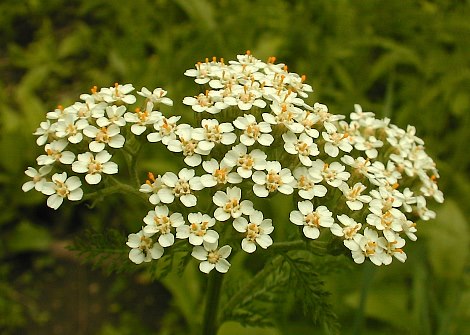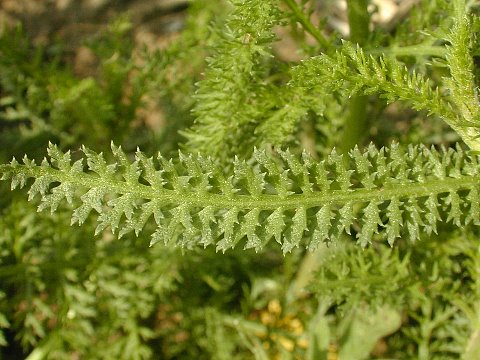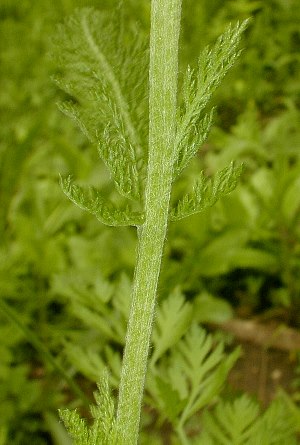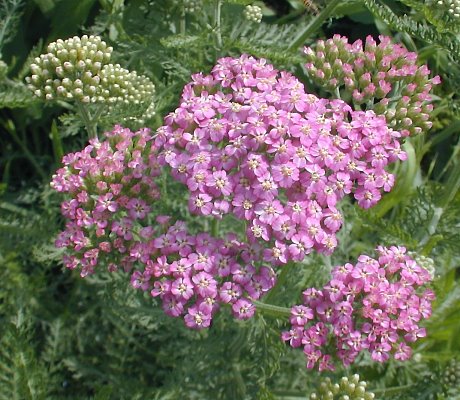Description: This perennial wildflower is about 1-2' tall. It is unbranched, except near the apex, where the flowerheads occur. The central stem is pale green and more or less covered with white cobwebby hairs. The alternate leaves are up to 6" long and 1" across, becoming slightly smaller as they ascend the stems. Each fern-like leaf is pale to medium green, elliptic in outline, and widest in the middle – however, its structure is either simple-pinnate or double-pinnate and its overlapping leaflets are either simple-pinnate or pinnatifid. The leaves and sometimes their leaflets (when they are simple-pinnate) are upward-angled along their rachises (central stalks), while pinnatifid leaflets and subleaflets are either curled, crinkled, or flat. Like the stems, the leaves and their subdivisions often have fine cobwebby hairs. The leaves are sessile.

The upper stems produce flat-headed panicles (compound corymbs) of small flowerheads. Each flowerhead is about ¼" across, consisting of 5 ray florets (their petaloid rays are white, rarely rose or other pastel colors) and a similar number of disk florets that have cream or pale yellow corollas. The petaloid rays are often slightly notched at their tips. The floral bracts (phyllaries) are pale green and lanceolate-oblong; they often have cobwebby hairs. All parts of this plant exude a distinctive aroma that is somewhat soapy and astringent. The blooming period occurs from early to mid-summer and lasts about a month. Each floret is replaced by an achene that is oblong and somewhat flattened; it lacks a tuft of hairs. The root system produces abundant rhizomes, often forming clonal colonies of plants.

Cultivation:
The
preference is full or partial sun, mesic to dry conditions, and a
somewhat heavy clay-loam soil.
Range & Habitat:
Yarrow is a common plant that has naturalized in all counties of
Illinois (see Distribution
Map). The variety of Yarrow that occurs in Illinois is
probably
native to Eurasia, although there is a variety of this plant that
is native to western North America. This latter variety tends to be
smaller in size and its foliage is more heavily covered with woolly
hairs. Habitats include mesic to dry prairies, pastures, fallow fields,
grassy waste areas, and edges of paths, yards, or hedges. Disturbed
areas are preferred; Yarrow persists in native habitats (e.g.,
prairies) to a limited extent. Yarrow is often cultivated in flower and
herbal gardens, from where it occasionally escapes.

Faunal Associations: The nectar and pollen of the flowerheads attract a wide variety of insects, including bees, wasps, ants, flies, beetles, butterflies, moths, and true bugs (Robertson, 1929, and others). For example, among the fly floral visitors of Yarrow (Achillea millefolium), there are soldier flies (Stratiomyidae), bee flies (Bombyliidae), Syrphid flies, thick-headed flies (Conopidae), Tachinid flies, flesh flies (Sarcophagidae), Muscid flies, blow flies (Calliphoridae), and Anthomyiid flies. Several species of grasshoppers feed destructively on Yarrow in open areas, including the Little Pasture Grasshopper (Melanoplus confusus) and Red-legged Grasshopper (Melanoplus femurrubrum); see Grasshopper Table. The Four-spotted Tree Cricket (Oecanthus quadripunctatus), Protean Shieldback (Atlanticus testaceus), and Straight-lanced Meadow Katydid (Conocephalus strictus) feed on the flowerheads (Gangwere, 1961; Gangwere, 1967). Other insects that feed on the foliage, stems, and other parts of Yarrow include the larvae of tumbling flower beetles, leaf beetles, larvae of the Yarrow Flower Midge (Ozirhincus millefolii), plant bugs, an introduced seed bug (Stygnocoris rusticus), the Yarrow Aphid (Macrosiphoniella millefolii) and other aphids, the Yarrow Mealybug (Chorizococcus dentatus) and other mealybugs, larvae of the Wavy-lined Emerald (Synchlora aerata) and other Geometer moths, larvae of the Voluble Dart (Agrotis volubilis) and other Noctuid moths, and the Eastern Flower Thrips (Frankliniella tritici). The Insect Table has a more complete listing of these species. Mammalian herbivores are reluctant to feed on the aromatic foliage of this plant, although overwintering leaves of Yarrow are eaten occasionally by the Cottontail Rabbit (Martin et al., 1951/1961).

Photographic
Location:
Judge Webber Park and Meadowbrook Park in Urbana, Illinois.
Comments:
Among members of the Aster family, the fern-like foliage of Yarrow is
rather unusual and it has a distinctive odor. Other members of the
Aster family with this kind of foliage include Anthemis spp.
(Mayweed), Matricaria spp. (Chamomile), and Tanacetum
vulgare (Tansy). Unlike Yarrow, species of Mayweed and
Chamomile produce daisy-like flowerheads with long petaloid rays. Tansy
is a larger plant with medium to dark green foliage. While its
flowerheads have a similar size and structure as compared to those of
Yarrow, they are bright yellow and their petaloid rays are even smaller
in size or absent.